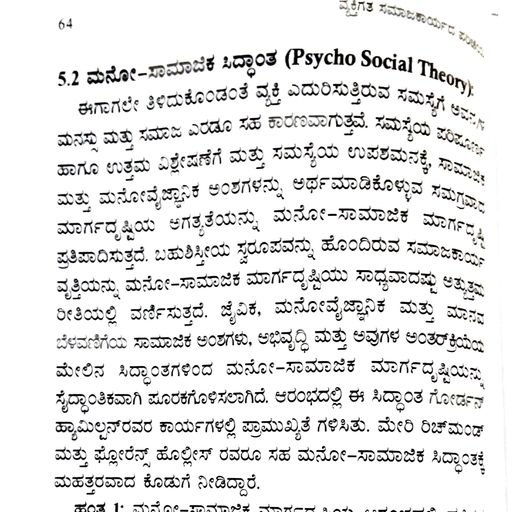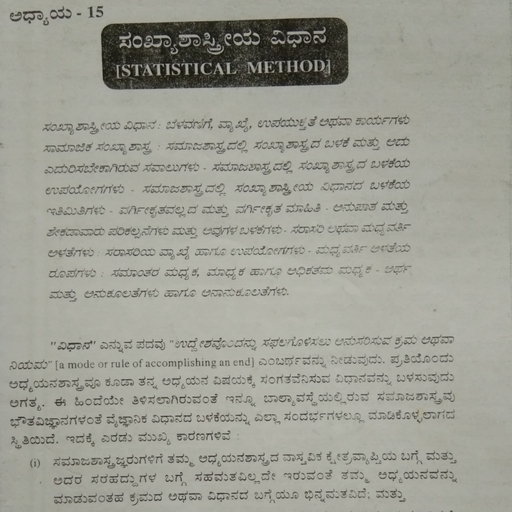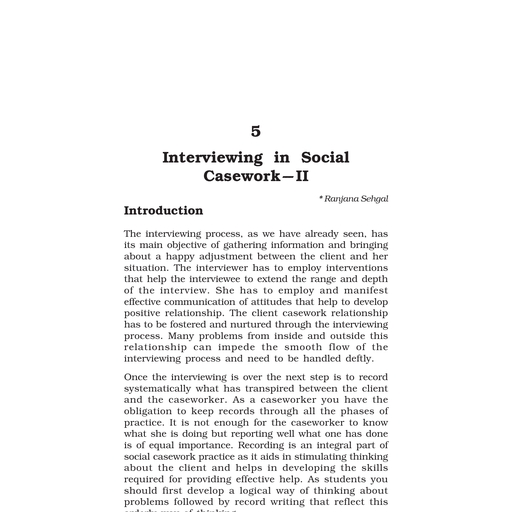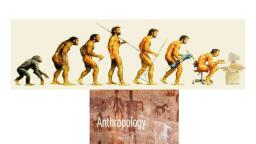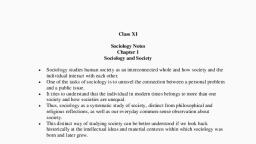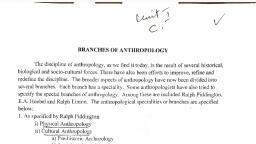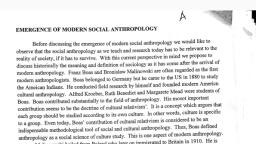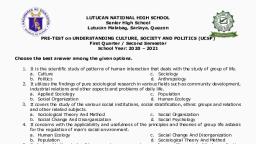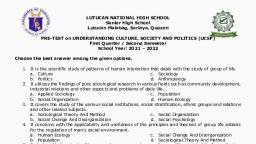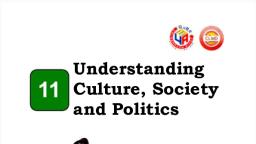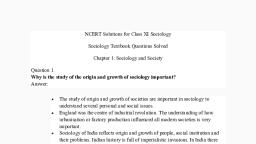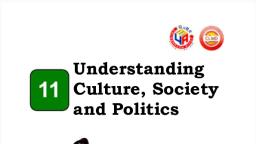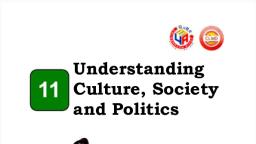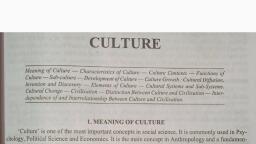Page 1 :
School of Distance Education, , , , , , MODULE 1, INTRODUCTION TO ANTHROPOLOGY, , Anthropology: definition, meaning , nature and scope., , Anthropology is the study of various elements of humans, including biology and culture, in order, to understand human origin and the evolution of various beliefs and social customs., , The term anthropology is a combination of two terms ‘anthropos’ and ‘logus’, the former, meaning human and the later meaning discourse or science. Thus anthropology is the science or, discourse of man. It is the science or discourse of human beings. Aristotle first used the term, ‘Anthropologist’., , Definitions of Anthropology, , 1. The concise oxford dictionary: study of mankind especially of its societies and customs;, study of structure and evolution of man as an animal”., , 2s Kroeber: “Anthropology is the science of groups of men and their behaviour and, production”., , 3. Herskovits: “Anthropology may be defined as the measurement of human beings.”, , 4. Jocobs and Stern: “Anthropology is the scientific study of the physical, social and, , cultural development and behaviour of human beings since their appearance on this earth.”, Divisions of Anthropology and their relationships, , Anthropology has been divided into two main branches: Physical anthropology and cultural, anthropology. These two main branches have been again, sub-divided into several other branches, which have been given in the following chart:, , Classification of anthropological sciences, , , , Anthropology, L, v v, Physical Anthropology Cultural Anthropology, Human Human Ethnology Anthropometry Biometry Prehistoric Social, Genetics Paleontology Archeology Anthropology, , , , Social Anthropology Page 5
Page 2 :
School of Distance Education, , , , , , LINTON’S CLASSIFICATION OF ANTHROPOLOGY, |, , , , v v, Physical Anthropology Cultural Anthropology, Human Paleontology Somatology Archeology Ethnology Linguistics, , PIDDINGTION’S CLASSIFICATION OF ANTHROPOLOGY, , Physical Anthropology Cultural Anthropology, Human Genetics Anthropometry Prehistoric Social, Or Somatology Anthropology Anthropology, , 1, Physical Anthropology: Physical anthology studies human body, genetic and the status of, man among living beings. Some of its definitions are as follows :, , J.E. Manchip White: “Physical anthropology is the study of bodily appearance of man.”, , Hoebel, “Physical anthropology is therefore the study of the physical characteristics of the human, race as such”., , M.H. Herskovits, “Physical anthropology is, in essence, human biology.”, Piddington, “Physical anthropology is concerned with the bodily characteristics of man.”, , Physical anthropology has now been divided into the following five branches according to the, specialization of study., , 1. Human Genetics: Human genetics is the branch of physical anthropology which studies, the genesis of man. Human genetics is the study of human heredity. It studies the human physical, characteristics that are transmitted through heredity from generation to generation., , 2. Human Palaeontology: Human palaeontology studies the old human skeletons of, different stages. It also studies the history of earth evolution. According to Webester’s New, International Dictionary, “Human palaeontology is the science that deals with life of the past, geographical periods. It is based on the study of the fossils remains as organisms.”, , 3. Ethnology: Ethnology studies human races. Ethnology classifies human races and studies, their physical characteristics. Ethnology is based upon anthropometry and biometrics, since both, these measure racial characteristics., , , , Social Anthropology Page 6
Page 3 :
School of Distance Education, , , , , , 4. Anthropometry: According to Herskovits, anthropometry may be defined as the, measurement of man. Anthropologists have decided certain definite traits by the measurement of, which human races may be classified. Anthropometry, again , has been classified into two, branches, study of the physical structures of living human beings and study of human fossils., , 5. Biometry: In the words of Charles Winik, Biometry is the statistical analysis of biological, studies specially as applied to such areas as disease, birth, growth and death”. Thus biometry is, the statistical study of biological characteristics., , 2. Cultural anthropology, , Cultural anthropology studies human cultures. In order to carry on his personal and social, life man invents some sort of system, develops and establishes it. This total system is culture. It is, social heritage. It is however, not transmitted through heredity. It is learned through imitation,, experience and understanding. Cultural anthropology studies human customs, mores, traditions,, social life, religion, art, science, literature and economic and political organization. According to, E.A. Hoebel. “The phase of anthropology that devotes its attention to the customs of mankind, is, called cultural anthropology”., , Cultural anthropology has been classified into the following two classes:, , 1. Prehistoric Archeology: literally speaking, archeology is the study of ancient time. Thus, it studies ancient things. Archeology studies the ancient history which has no written records., Things and articles discovered by archeological excavations give us an idea about the culture of, the people using them. It records cultural successes of a particular era and also area of its, expansions., , 2. Social anthropology: social anthropology as is clear by the nomenclature, studies social, organization and social institutions. According to Firth, “One of the broadest ways of defining, social anthropology is to say that it studies human social processes comparatively.”, , Physical anthropology and cultural anthropology are closely related. Different branches of, physical anthropology have close bearing upon the study of social anthropology, a branch of, cultural anthropology. Again archeology has been helpful in the study of various branches of, physical anthropology., , Social Anthropology, , Social anthropology is an important branch of anthropology. Social anthropology is social., This meaning of the word ‘social’ is enough to show how the field and viewpoint of social, anthropology is different from other branches of anthropology. Some definitions of social, anthropology are as follows:, , 1s Piddington: “Social anthropologists study cultures of contemporary primitive, communities.” This definition of social anthropology is a bit narrow because anthropology does, , , , Social Anthropology Page7
Page 4 :
School of Distance Education, , , , , , not only study primitive cultures but studies contemporary cultures also. From this point of view,, the definition of social anthropology given by S.C. Dubey is more appropriate., , 2. S.C. Dube: “Social anthropology is that part of cultural anthropology which devotes its, primary attention to the study of social structure and religion rather than material aspects of, culture.” It is clear that social anthropology studies the different aspects of social structure such as, social institutions, social relations and social events, etc., , 3. Penniman: “That part of cultural anthropology which treats of social phenomena is called, social anthropology”., , 4. MLN. Srinivas: “it is a comparative study of human societies. Ideally, it includes all, societies, primitive, civilized and historic.” Dr. Srinivas has given a sufficiently detailed, definition of social anthropology., , 3: Charles Winick: “social anthropology is the study of social behaviour, especially from, the point of view of the systematic comparative study of social forms and institutions.”, , In brief, social anthropology is a comparative study of social behaviour and social phenomena of, men of all countries and ages., , Scope of social anthropology, , While defining social anthropology, Beals and Hoijer write that “it is concemed with, culture per se, whether it belongs to the primitive men of the stone age or the European citydwellers of today.” Although it is more properly a definition of cultural anthropology, yet it surely, and clearly shows that the field of social anthropology is very wide. It includes a study of, different parts of culture, social institutions and economic and political administration. The main, branches of social anthropology are given below:, , 1. Ethnography, , 2. Familial anthropology, , 3 Economic anthropology, , 4 Political anthropology, , a Symbology and linguistics, 6 Thought and Art, , . Ethnography: Ethnography is the main field of social anthropology. As is clear from its name, it, studies the human race. Its scope also includes the study of cultures of different races., , Familial anthropology: Family is the basic institution of society. Social anthropology, therefore,, studies the family also. This branch of social anthropology is known as familial anthropology. It, takes up a comparative study of the families of different cultures and societies. It studies the, different forms of family along with its progress. A family is based on marriage. Familial, , , , Social Anthropology Page&
Page 5 :
School of Distance Education, , , , , , anthropology therefore, includes a study of different forms of marriage. It also includes other, blood relations along with marriage., , 3. Economic anthropology: Economic rules play an important art in social organization. Some, radical changes take place in social structure along with a change in economic administration., Social anthropology, therefore, minutely studies the economic administration of primitive and, civilized human societies and of different levels of evolution in them., , 4. Political anthropology: Political anthropology has also an important place in social structure, along with economic administration. Social anthropology, therefore, studies all types of political, administration, laws, governments and rules of punishment, etc. This branch of social, anthropology is known as political anthropology., , 5. Symbology and Linguistics: the study of different symbols of human behaviour, which are, current n languages of different societies, supplies many important facts for the study of society., Social anthropology, therefore, studies all these also. The whole linguistic field falls within this, branch of social anthropology. The main branches of linguistics are given below:, , i) Descriptive Linguistics: it studies the individual and regional languages;, ii) Historical Linguistics: It s a historical study of languages;, iii) Comparative Linguistics: It studies the comparative fact about language;, , iv) Common Linguistics: It studies the difference between the minimum and maximum roots of some, languages., , 6. Thought and Art: the study of thoughts in theoretical study s very important. Thought includes, religion, magic, science and even legends. Social anthropology is a comparative study of all these, things in ancient human society. Art is an important part of culture and culture depicts the interior, of a society. Social anthropology studies sculpture, metallurgy, and even dancing and, instrumental and vocal music., , Social Anthropology and Cultural Anthropology, , Dr. D.N. Majumdar and other contemporary anthropologists have regarded social, anthropology as a part of cultural anthropology. Cultural anthropology studies the mode of life of, the contemporary primitive man. Cultural anthropology has four branches, e.g. linguistics and, symbology, thought and art, economic anthropology and social anthropology. Social, anthropology studies the different kinds of social life and its evolution. In this way, according to, Dr. Majumdar, linguistics, symbology, economic anthropology and thought and art are outside the, scope of social anthropology. According to this point of view, familial anthropology and political, anthropology only form the part of social anthropology. This is clear from the aforesaid, discussion about the scope of social anthropology. But familial anthropology and political, anthropology are closely related to the other branches. American anthropologist, Morgan, was the, founder of social anthropology. Social anthropology and cultural anthropology differ more in, their subject matter than in their mode and percepts. While culture anthropology studies cultures,, , , , Social Anthropology Page 9
